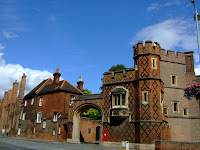 As Kiwis from the other side of the globe, it is amazing how much of what we learnt in history is tangible and preserved in the UK.
As Kiwis from the other side of the globe, it is amazing how much of what we learnt in history is tangible and preserved in the UK.A one-hour drive from London takes you to Stratfield Saye, the country home of the Duke of Wellington, purchased with funds given by a grateful nation to a national hero and national treasure.
 Wellington originally had plans for a grand palace, not unlike Blenheim Palace, from the designs on display, but he eventually decided to make the existing dwelling on the property more comfortable. The result is a homely house, still very similar to the way it was when the Duke came down from London, and still lived in by his descendants.
Wellington originally had plans for a grand palace, not unlike Blenheim Palace, from the designs on display, but he eventually decided to make the existing dwelling on the property more comfortable. The result is a homely house, still very similar to the way it was when the Duke came down from London, and still lived in by his descendants. His favourite charger, Copenhagen, survived all the battles with Wellington and lived to the ripe old age of 28. The horse was buried with full military honours and, so the story goes, the enormous oak tree growing on the grave, grew from an acorn tossed in the grave by his housekeeper. This was one of many stories told by the elderly tour guide, who made the tour extremely interesting with anecdotes from the lives of the family.
His favourite charger, Copenhagen, survived all the battles with Wellington and lived to the ripe old age of 28. The horse was buried with full military honours and, so the story goes, the enormous oak tree growing on the grave, grew from an acorn tossed in the grave by his housekeeper. This was one of many stories told by the elderly tour guide, who made the tour extremely interesting with anecdotes from the lives of the family. Following in the footsteps of Wellington's and his three sons, we went to Eton, in time for a guided tour of the school. It was interesting to hear the history of the school, and have a look around the original school, including the first classroom - one of the two earliest existing classrooms in England - the cloisters and chapel. Eton was set-up by King Henry 6th, as was Kings College in Cambridge. As the alma mater of 18 British Prime Ministers Eton must rank as a national treasure.
Following in the footsteps of Wellington's and his three sons, we went to Eton, in time for a guided tour of the school. It was interesting to hear the history of the school, and have a look around the original school, including the first classroom - one of the two earliest existing classrooms in England - the cloisters and chapel. Eton was set-up by King Henry 6th, as was Kings College in Cambridge. As the alma mater of 18 British Prime Ministers Eton must rank as a national treasure. We then followed a very pleasant figure-of-eight walk, which crossed the River Thames to Windsor, with a walk past the castle walls and up the Long Walk Walk as well as a short walk along the shortest street in England; Queen Charlotte St – 51’ 10”. The number of tourists drawn here by the Castle and spending their tourist pounds makes Windsor our third national treasure for the day.
We then followed a very pleasant figure-of-eight walk, which crossed the River Thames to Windsor, with a walk past the castle walls and up the Long Walk Walk as well as a short walk along the shortest street in England; Queen Charlotte St – 51’ 10”. The number of tourists drawn here by the Castle and spending their tourist pounds makes Windsor our third national treasure for the day.




No comments:
Post a Comment